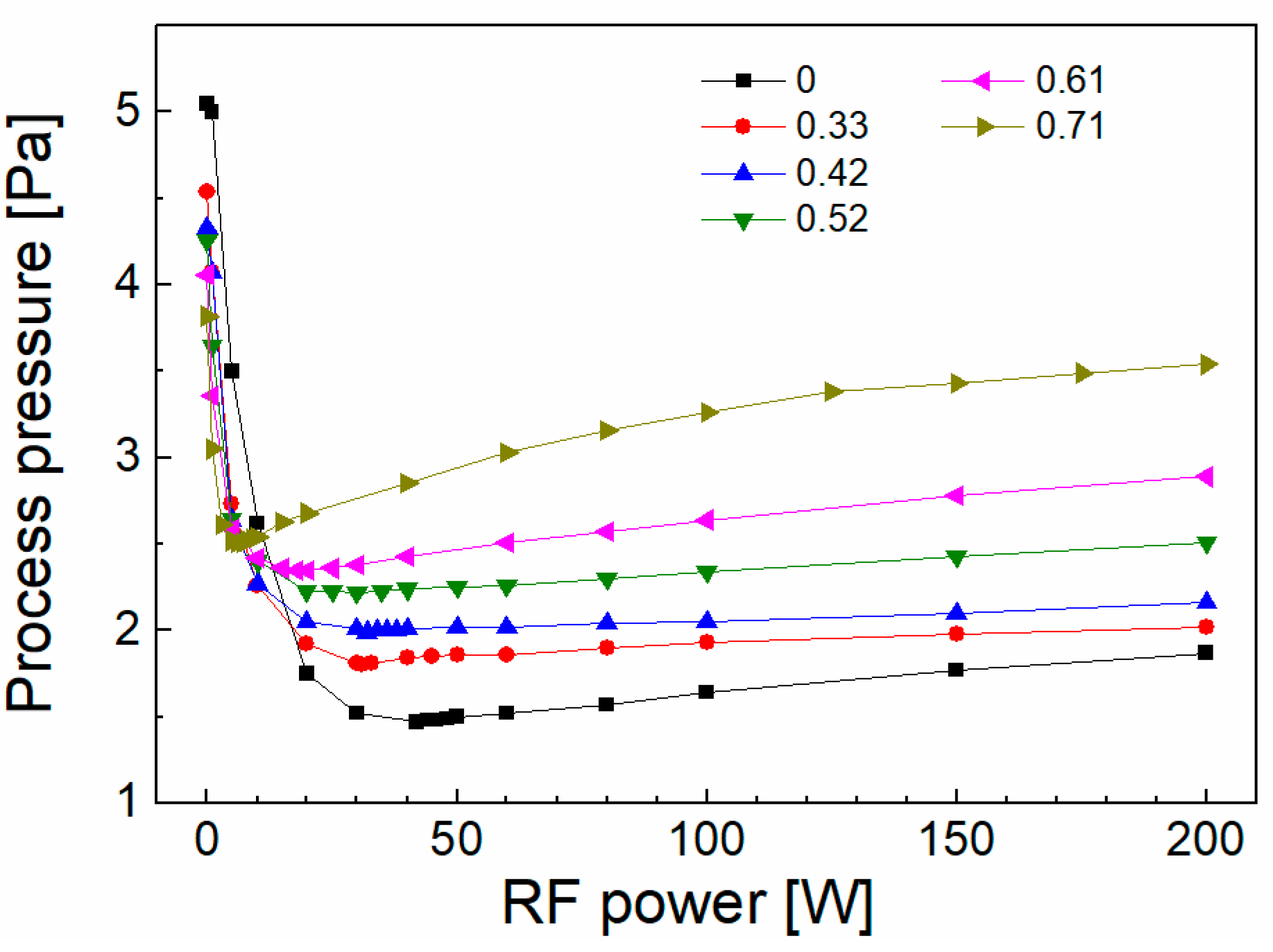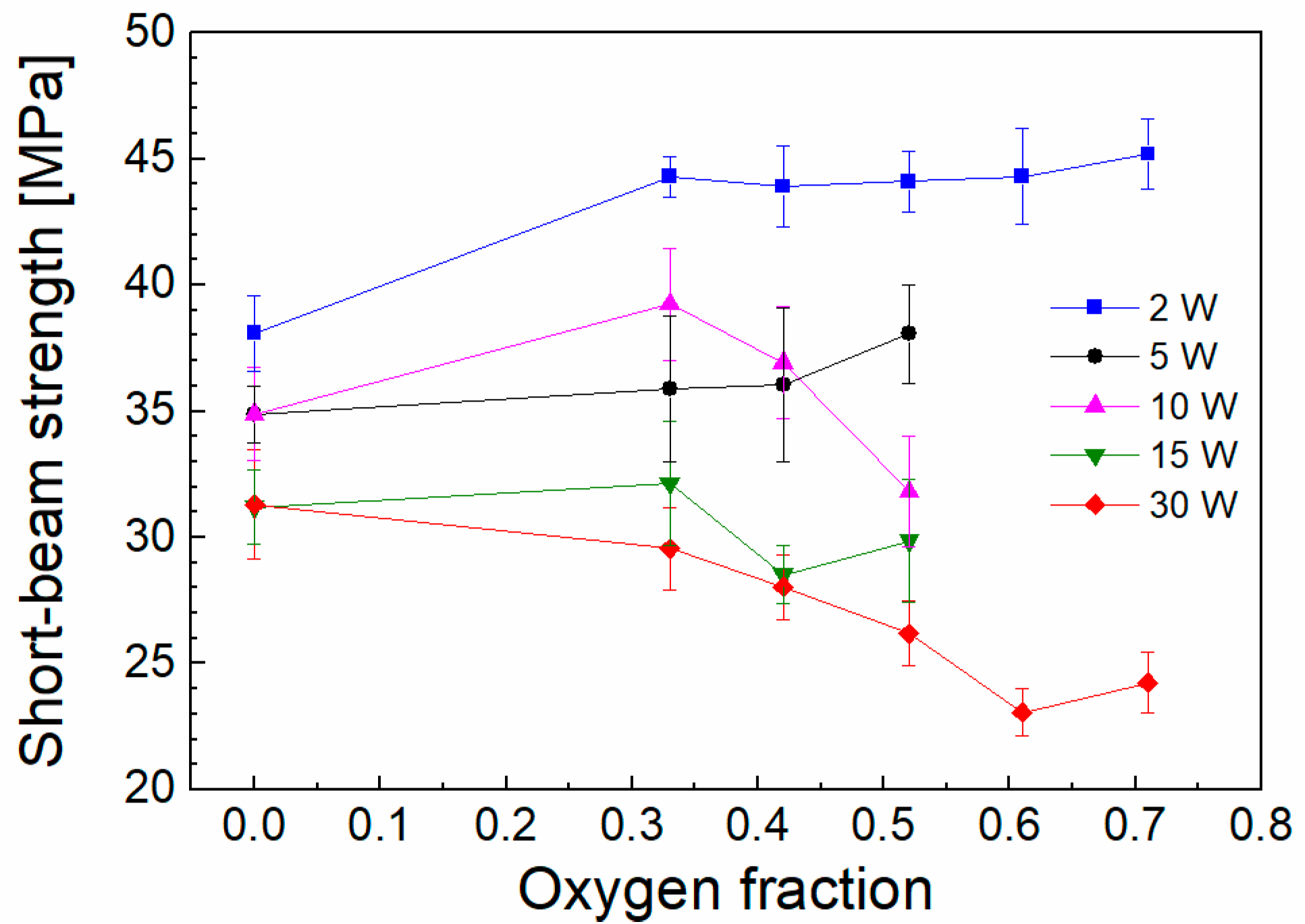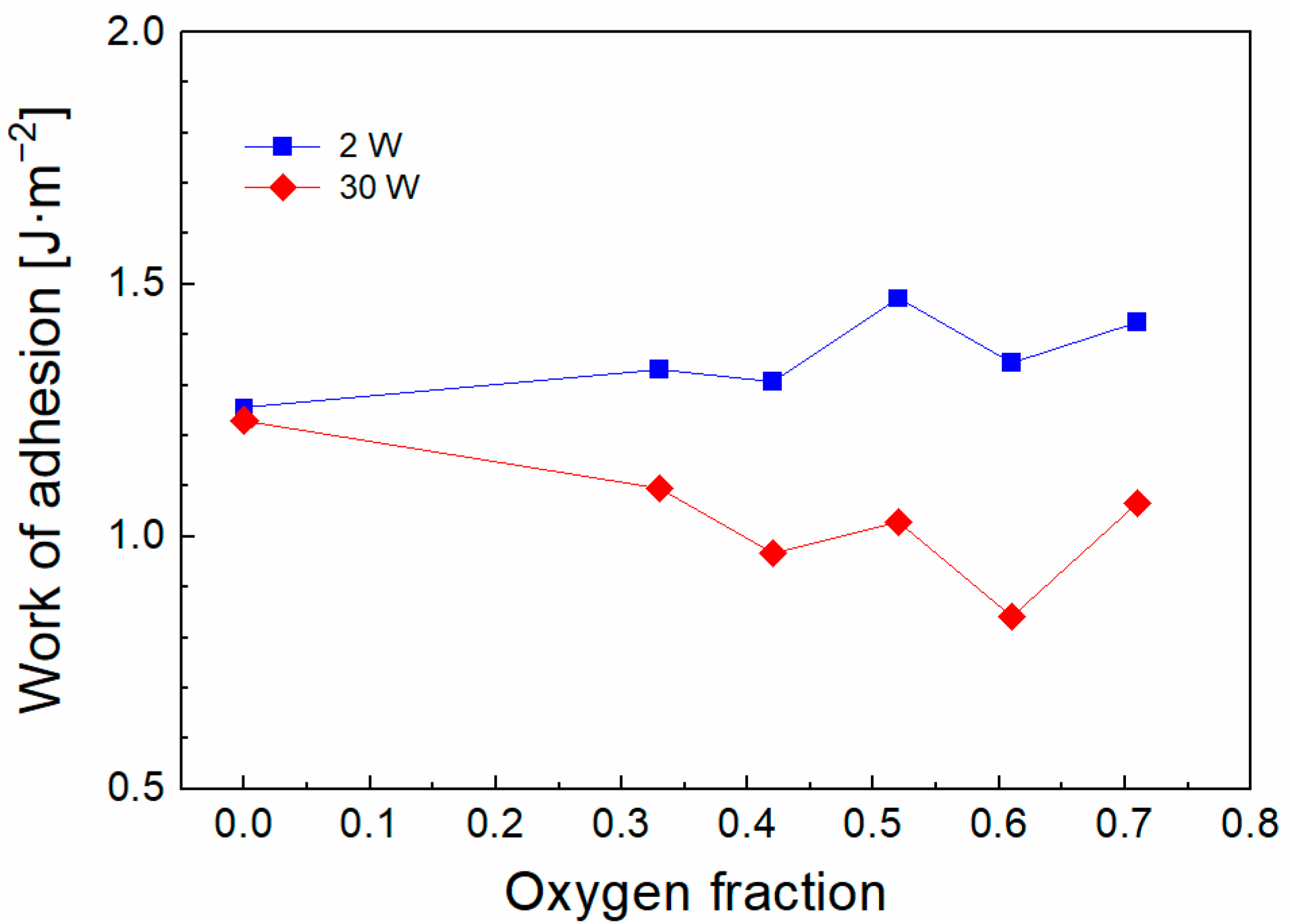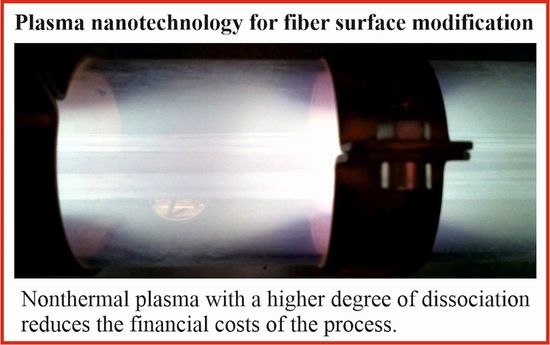Shear Strength Range of GF/Polyester Composites Controlled by Plasma Nanotechnology
Abstract
1. Introduction
2. Materials and Methods
3. Results and Discussion
4. Conclusions
Author Contributions
Funding
Institutional Review Board Statement
Data Availability Statement
Acknowledgments
Conflicts of Interest
References
- Fang, C.; Zhou, Y.; Jia, L.; Yan, R. Interfacial properties of multicomponent plasma-modified high-performance fiber-reinforced composites: A review. Polym. Compos. 2022, 43, 4866–4883. [Google Scholar] [CrossRef]
- Jurko, M.; Souckova, L.; Prokes, J.; Cech, V. The effect of glass fiber storage time on the mechanical response of polymer composite. Polymers 2022, 14, 4633. [Google Scholar] [CrossRef] [PubMed]
- Xian, G.; Guo, R.; Li, C.; Hong, B. Mechanical properties of carbon/glass fiber reinforced polymer plates with sandwich structure exposed to freezing-thawing environment: Effects of water immersion, bending loading and fiber hybrid mode. Mech. Adv. Mater. Struct. 2023, 30, 814–834. [Google Scholar] [CrossRef]
- Yang, X.; Chen, Y.; Zhang, C.; Duan, G.; Jiang, S. Electrospun carbon nanofibers and their reinforced composites: Preparation, modification, applications, and perspectives. Compos. Part B 2023, 249, 110386. [Google Scholar] [CrossRef]
- Karoly, Z.; Romanszki, L.; Weltz, G.; Mohai, M.; Moczo, J.; Klebert, S. Comparison of dielectric barrier discharge and radio-frequency plasma processing of carbon fibers. Express Polym. Lett. 2021, 15, 1004–1017. [Google Scholar] [CrossRef]
- Kantharaju, S.; Vinodhini, J.; Govindaraju, M.; Bhowmik, S. An investigation to enhance the mechanical property of high-performance thermoplastic composite through different plasma treatment. Polym. Compos. 2023, 44, 178–189. [Google Scholar] [CrossRef]
- Fang, C.Y.; Chen, Y.C.; Jia, L.X.; Yan, R.S. Cold nitrogen plasma treated glass fiber warp knitted structural composites: Mechanical properties and response surface analysis. J. Ind. Text. 2022, 52, 1–16. [Google Scholar] [CrossRef]
- Zhang, L.; Xia, Z.C.; He, Y.D.; Xin, C.L.; Yu, Y.; Ren, F.; Wang, R.X. Fiber reinforced polypropylene composites interfacial behavior improvement fabricated by cold plasma jet SiOx nanoparticles deposition. J. Compos Mater. 2023, 57, 1185–1198. [Google Scholar] [CrossRef]
- Xu, T.; Qi, Z.; Yin, Q.; Jiao, Y.; An, L.; Tan, Y. Effects of air plasma modification on aramid fiber surface and its composite interface and mechanical properties. Polymers 2022, 14, 4892. [Google Scholar] [CrossRef]
- Li, C.Y.; Song, J.J.; Xing, W.J.; Wang, L.X.; Cui, Y.Y.; Pei, X.Y. Mechanical properties of interlayer hybrid textile composite materials based on modified aramid and UHMWPE fabrics. Polym. Adv. Technol. 2023, 34, 205–216. [Google Scholar] [CrossRef]
- Mohammed, M.; Rasidi, M.S.M.; Mohammed, A.M.; Rahman, R.; Osman, A.F.; Adam, T.; Betar, B.O.; Dahham, O.S. Interfacial bonding mechanisms of natural fibre-matrix composites: An overview. BioResources 2022, 17, 7031–7090. [Google Scholar] [CrossRef]
- Gupta, U.S.; Tiwari, S. Mechanical and surface characterization of sisal fibers after cold glow discharge argon plasma treatment. Biomass Convers. Biorefinery 2022, 1–15. [Google Scholar] [CrossRef]
- Pillai, R.R.; Thomas, V. Plasma surface engineering of natural and sustainable polymeric derivatives and their potential applications. Polymers 2023, 15, 400. [Google Scholar] [CrossRef]
- Periasamy, K.; Kandare, E.; Das, R.; Darouie, M.; Khatibi, A.A. Interfacial engineering methods in thermoplastic composites: An overview. Polymers 2023, 15, 415. [Google Scholar] [CrossRef]
- Kosmachev, P.V.; Panin, S.V.; Panov, I.L.; Bochkareva, S.A. Surface Modification of carbon fibers by low-temperature plasma with runaway electrons for manufacturing PEEK-based laminates. Materials 2022, 15, 7625. [Google Scholar] [CrossRef]
- Cech, V.; Knob, A.; Hosein, H.A.; Babik, A.; Lepcio, P.; Ondreas, F.; Drzal, L.T. Enhanced interfacial adhesion of glass fibers by tetravinylsilane plasma modification. Compos. Part A 2014, 58, 84–89. [Google Scholar] [CrossRef]
- Cech, V.; Prikryl, R.; Balkova, R.; Grycova, A.; Vanek, J. Plasma surface treatment and modification of glass fibers. Compos. Part A 2002, 33, 1367–1372. [Google Scholar] [CrossRef]
- Wu, M.J.; Jia, L.X.; Lu, S.L.; Qin, Z.G.; Wei, S.N.; Yan, R.S. Interfacial performance of high-performance fiber-reinforced composites improved by cold plasma treatment: A review. Surf. Interfaces 2021, 24, 101077. [Google Scholar] [CrossRef]
- Zvonek, M.; Sirjovova, V.; Branecky, M.; Plichta, T.; Skacel, J.; Cech, V. Plasma nanocoatings developed to control the shear strength of polymer composites. Polymers 2019, 11, 1188. [Google Scholar] [CrossRef]
- Plichta, T.; Sirjovova, V.; Zvonek, M.; Kalinka, G.; Cech, V. The adhesion of plasma nanocoatings controls the shear properties of GF/polyester composite. Polymers 2021, 13, 593. [Google Scholar] [CrossRef]
- Cech, V.; Knob, A.; Lasota, T.; Lukes, J.; Drzal, L.T. Surface modification of glass fibers by oxidized plasma coatings to improve interfacial shear strength in GF/polyester composites. Polym. Compos. 2019, 40, E186–E193. [Google Scholar] [CrossRef]
- Cech, V.; Marek, A.; Knob, A.; Valter, J.; Branecky, M.; Plihal, P.; Vyskocil, J. Continuous surface modification of glass fibers in a roll-to-roll plasma-enhanced CVD reactor for glass fiber/polyester composites. Compos. Part A 2019, 121, 244–253. [Google Scholar] [CrossRef]
- Technical Data Sheet DISTITRON® 183 B1. Available online: https://www.polynt.com/wp-content/uploads/tds/DISTITRON_183_B1_EN.pdf (accessed on 1 August 2023).
- ASTM D2344; Standard Test Method for Short-Beam Strength of Polymer Matrix Composite Materials and Their Laminates. American Society for Testing and Materials: West Conshohocken, PA, USA, 2001.
- Cech, V.; Branecky, M. Synthesis of thin-film materials using nonthermal plasma at a higher degree of dissociation. Plasma. Process. Polym. 2023, 20, e2300019. [Google Scholar] [CrossRef]
- Ohring, M. Materials Science of Thin Films; Academic Press: San Diego, CA, USA, 2002; pp. 58–63. [Google Scholar]
- Mitchell, B.S. Materials Engineering and Science for Chemical and Materials Engineers; Wiley: Hoboken, NJ, USA, 2004; p. 851. [Google Scholar]
- Houdkova, J.; Branecky, M.; Plichta, T.; Jiricek, P.; Zemek, J.; Cech, V. Chemical depth profile of layered a-CSiO:H nanocomposites. Appl. Surf. Sci. 2018, 456, 941–950. [Google Scholar] [CrossRef]
- Prikryl, R.; Cech, V.; Kripal, L.; Vanek, J. Adhesion of pp-VTES films to glass substrates and their durability in aqueous environments. Int. J. Adhes. Adhes. 2005, 25, 121–125. [Google Scholar] [CrossRef]
- Palesch, E.; Knob, A.; Plichta, T.; Cech, V. Functional interlayers with controlled adhesion developed for polymer composites. Thin Solid Films 2018, 656, 37–43. [Google Scholar] [CrossRef]




Disclaimer/Publisher’s Note: The statements, opinions and data contained in all publications are solely those of the individual author(s) and contributor(s) and not of MDPI and/or the editor(s). MDPI and/or the editor(s) disclaim responsibility for any injury to people or property resulting from any ideas, methods, instructions or products referred to in the content. |
© 2023 by the authors. Licensee MDPI, Basel, Switzerland. This article is an open access article distributed under the terms and conditions of the Creative Commons Attribution (CC BY) license (https://creativecommons.org/licenses/by/4.0/).
Share and Cite
Sirjovova, V.; Zvonek, M.; Jurko, M.; Cech, V. Shear Strength Range of GF/Polyester Composites Controlled by Plasma Nanotechnology. Polymers 2023, 15, 3331. https://doi.org/10.3390/polym15163331
Sirjovova V, Zvonek M, Jurko M, Cech V. Shear Strength Range of GF/Polyester Composites Controlled by Plasma Nanotechnology. Polymers. 2023; 15(16):3331. https://doi.org/10.3390/polym15163331
Chicago/Turabian StyleSirjovova, Veronika, Milan Zvonek, Michal Jurko, and Vladimir Cech. 2023. "Shear Strength Range of GF/Polyester Composites Controlled by Plasma Nanotechnology" Polymers 15, no. 16: 3331. https://doi.org/10.3390/polym15163331
APA StyleSirjovova, V., Zvonek, M., Jurko, M., & Cech, V. (2023). Shear Strength Range of GF/Polyester Composites Controlled by Plasma Nanotechnology. Polymers, 15(16), 3331. https://doi.org/10.3390/polym15163331








